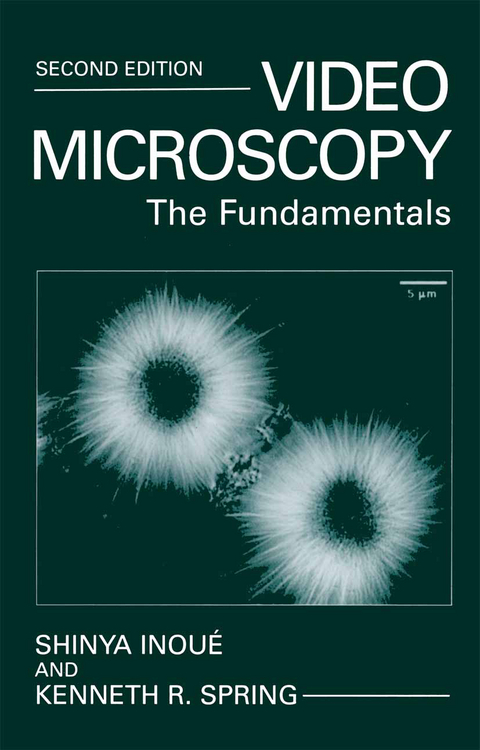
Video Microscopy
Kluwer Academic/Plenum Publishers (Verlag)
978-0-306-45531-5 (ISBN)
1 Why Video?.- 1.1. Pre-1940: The Invention of TV.- 1.2. Earlier Applications of Video to Microscopy.- 1.3. Where We Are Today.- 1.4. A Few General Remarks.- 2 Microscope Image Formation.- 2.1. Introduction: Essential Optical Train of the Light Microscope.- 2.2. Imaging Components in the Light Microscope: Magnification.- 2.3. Principles of Koehler Illumination.- 2.4. Image Resolution and Wave Optics.- 2.5. Performance Characteristics of Microscope Optics.- 2.6. Generation of Image Contrast.- 2.7. Scanning Microscopy.- 2.8. Optical Sectioning, Stereoscopy, and 3-D Imaging.- 2.9. Image Reduction and Optical Manipulation of the Specimen with the Light Microscope.- 3 Practical Aspects of Microscopy.- 3.1. Adjusting the Microscope for Koehler Illumination.- 3.2. Light Sources and Microscope Image Brightness.- 3.3. Choice and Care of Lenses for Video Microscopy.- 3.4. The Microscope Stand.- 4 Physiological Characteristics of the Eye.- 4.1. Introduction.- 4.2. Structure, Refraction, and Accommodation of the Human Eye.- 4.3. Visual Sensitivity and Adaptation.- 4.4. Resolution, Visual Acuity.- 4.5. Contrast Discrimination and the Modulation Transfer Function.- 4.6. Flicker.- 4.7. Color Vision.- 4.8. Stereoscopy.- 4.9. Additional Remarks.- 5 Video Signal Fundamentals.- 5.1. The Video Image and Signal.- 5.2. How Video Works.- 5.3. Timing Pulses and the Composite Video Signal.- 5.4. Image Resolution and the Video Signal.- 5.5. Synchronizing the Video Equipment.- 6 Detection of Light and Monochrome Vidicon Cameras.- 6.1. Photomultiplier Tubes.- 6.2. Imaging: From Photomultiplier Tubes to Video.- 6.3. Characterizing Video Sensors.- 6.4. Performance Comparisons.- 7 Solid-State Detectors and Cameras.- 7.1. Simple Solid-State Detectors.- 7.2. Spatial Discrimination with Solid-State Detector Arrays.- 7.3. CCD Fundamentals.- 7.4. Other Video-Rate Solid-State Sensors and Cameras.- 7.5. Slow-Scan CCD Cameras.- 7.6. High-Speed Imaging with Solid-State Detectors.- 8 Low-Light-Level Cameras.- 8.1. The Development of Low-Light-Level Video-Rate Cameras.- 8.2. Newer-Generation Image Intensifiers.- 8.3. Coupling Intensifiers to Video-Rate Cameras and Slow-Scan CCDs.- 8.4. Photon-Counting Detectors.- 8.5. Low-Light-Level Imaging Requirements in Microscopy.- 9 Color Video Signal and Color Cameras.- 9.1. Color Fundamentals.- 9.2. Color Video Encoding.- 9.3. Color Video Cameras.- 9.4. Some Considerations Regarding Color Signals.- 10 Video Monitors, Projectors, and Printers.- 10.1. Some General Considerations.- 10.2. Monochrome CRT Video Monitors.- 10.3. Color CRT Video Monitors.- 10.4. Solid-State and Plasma Display Monitors—Monochrome and Color.- 10.5. Video Projectors.- 10.6. Video Printers and Production of Video Micrographs.- 10.7. Optical Copying with Video.- 10.8. Stereo Video Displays.- 11 Video Recorders.- 11.1. Introduction.- 11.2. Video Tape Recording.- 11.3. Videotape Formats—Monochrome and Color.- 11.4. Characterization of VTRs for Video Microscopy.- 11.5. Time-Lapse VTRs, Time-Base Errors, High-Speed VTRs.- 11.6. Care and Maintenance of the VCR.- 11.7. Choice and Care of the Videotape.- 11.8. Copying and Editing onto Videotape.- 11.9. Special Effects.- 11.10. Video Disk Recorders.- 11.11. Digital Video Recording.- 12 Digital Image Processing.- 12.1. Introduction.- 12.2. Digital Image Acquisition.- 12.3. Image Processor Architecture.- 12.4. Digital Signal Processing.- 12 5 Image Analysis—Measurement of Intensity.- 12.6. Image Analysis—Morphometric Operations.- 12.7. Image Processing—Convolutions, Filters, Transforms.- 12.8. Display of DigitizedImages.- 13 System Integration.- 13.1. Initial Adjustments and Connections in a Basic System.- 13.2. Component Selection.- 13.3. Making Connections.- 13.4. Reducing Noise.- 13.5. Environmental Considerations.- 13.6. The Limits of Video Microscopy.- Postscript.- References.- List of Manufacturers.
| Erscheint lt. Verlag | 31.8.1997 |
|---|---|
| Zusatzinfo | XXVIII, 742 p. |
| Verlagsort | New York |
| Sprache | englisch |
| Maße | 170 x 244 mm |
| Themenwelt | Informatik ► Weitere Themen ► Hardware |
| Medizin / Pharmazie ► Medizinische Fachgebiete ► Geriatrie | |
| Studium ► 1. Studienabschnitt (Vorklinik) ► Anatomie / Neuroanatomie | |
| Naturwissenschaften ► Biologie | |
| Naturwissenschaften ► Physik / Astronomie ► Mechanik | |
| ISBN-10 | 0-306-45531-5 / 0306455315 |
| ISBN-13 | 978-0-306-45531-5 / 9780306455315 |
| Zustand | Neuware |
| Haben Sie eine Frage zum Produkt? |
aus dem Bereich


